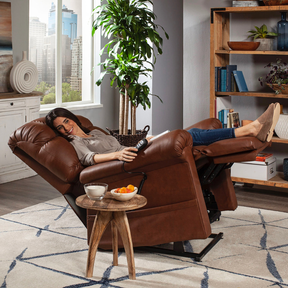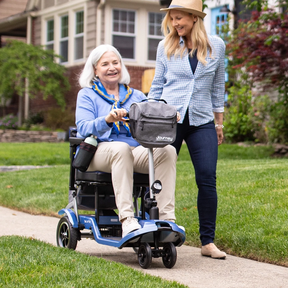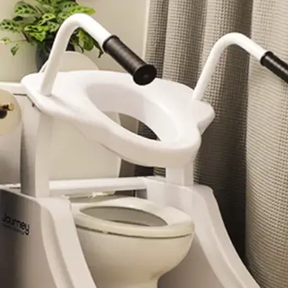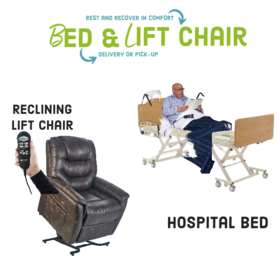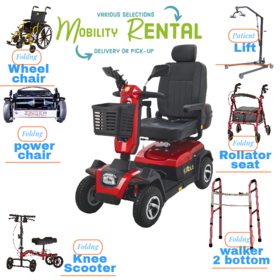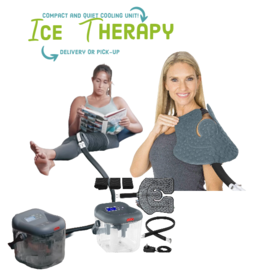Blog Compression Socks 101: Your Guide to Finding the Best Fit for Better Blood Circulation
Sat, 07/01/2023 - 19:53
Compression socks are a type of specialized hosiery that enhance blood circulation by exerting pressure on the legs, ankles, and feet. They work by compressing the veins and muscles in the lower leg, which helps the blood flow back up to the heart. The benefits of wearing compression socks include reduced swelling and soreness in the legs, as well as a decreased risk of blood clots. It's important to choose the right type and size of compression socks to get the maximum benefit. So, let's dive into this comprehensive guide and find out everything you need to know about compression socks!
Types of Compression Socks
When it comes to compression socks, there are three main types: graduated compression socks, anti-embolism compression socks, and non-medical compression socks.
Graduated Compression Socks: Graduated compression socks are designed to provide the highest compression at the ankle, with gradually diminishing pressure up the leg. They are commonly used to help improve blood circulation, reduce swelling, and prevent blood clots.
Anti-embolism compression socks: Anti-embolism compression socks provide a uniform amount of pressure throughout the leg, promoting blood flow and helping to prevent blood clots. They are typically worn during bed rest or recovery periods.
Non-medical compression socks: Non-medical compression socks are often used during high-intensity sports activities. They typically have lower compression levels than the other types of compression socks and are designed to reduce muscle fatigue and support muscles during exercise.
Whether you are looking for medical or athletic compression, there are a variety of styles and materials available to choose from. It's important to consult your healthcare provider to determine the appropriate compression level and type of sock for your individual needs.

Choosing the Best Compression Socks:
When it comes to choosing the best compression socks, there are a few vital things to consider. First off, you need to determine the right level of compression you require. You can choose from mild, moderate, and high compression levels based on your needs. If you are looking for something that can help prevent mild swelling in your ankles and legs, then mild compression socks might be the right choice for you. For more severe swelling and conditions like varicose veins or post-surgery recovery, you might require higher compression levels. Remember, it is always best to consult with a medical professional before choosing the right compression level for your specific condition.
Another factor to consider is the type of compression material in the socks. Popular materials like nylon, spandex, and polyester are often used in compression socks. However, there are also natural materials like cotton and bamboo, which provide excellent breathability and moisture control.
Sizing and fit are also significant factors when choosing the right compression socks. Ensure you have accurate measurements of your feet and legs before purchasing, as compression socks that are too tight or too loose can cause discomfort and even foot or skin injuries. Always refer to the manufacturer's size charts or consult with a specialist before ordering to ensure you get the perfect fit.
When selecting compression, remember to determine the appropriate level of compression you require, consider the type of compression material used, and ensure you get a comfortable and accurate fit from the socks. With these factors in mind, you can find the best compression socks that offer better blood circulation, reduce swelling, and help maintain healthy legs and feet.
When to wear compression socks
Compression socks not only provide relief for aching feet and swollen ankles, but they're also helpful for various situations. During long flights or car rides, compression socks can reduce the risk of blood clots by promoting proper blood flow. Pregnant women can also benefit from wearing compression socks by improving blood circulation and reducing the risk of varicose veins.
Another instance when you may want to wear compression socks is after surgery. They can help reduce the risk of blood clots and promote healthy blood flow during recovery. Finally, athletes may also benefit from wearing compression socks during exercise, as they can improve muscle recovery and reduce fatigue.
Regardless of when you choose to wear them, it's important to choose the right socks for the situation. Consider the level of compression needed, the types of materials, and proper sizing and fit. Taking care of your compression Compression Socks is also important, as they can lose their effectiveness if not properly washed and dried.
All in all, wearing compression can definitely be helpful in promoting better blood circulation and overall foot health. So, if you're in need of relief after a long day on your feet or looking to prevent blood clots during travel or recovery, consider investing in a pair of compression socks.
Caring for your compression socks
Caring for your compression socks is crucial to preserve their effectiveness and lifespan. You should regularly wash and dry them to maintain their compression level and keep them free from bacteria and odour. Most socks are machine washable, but make sure to use a mild detergent and avoid bleach and fabric softeners. To dry, lay them flat or hang them, but never put them in the dryer.
It's important to know when to replace your compression socks too. As a general rule of thumb, they should be replaced every three to six months, or as advised by your doctor. Signs that it's time to replace them include decreased compression level, stretching, or holes. Proper care and maintenance can help you get the most out of your compression socks, ensuring that they continue to provide the support and comfort you need.
Tips for wearing compression socks comfortably:
Putting on socks can be a bit of a challenge, but with some practice, you will become a pro in no time. When putting them on, make sure your skin is dry - wet skin makes it much harder to get the socks on. It's also a good idea to use some powder or gloves to reduce friction and help them slide on. Don't just rush into it; roll the sock down to the heel, place it on your foot, and then gently pull it up, making sure there are no wrinkles or creases.
Taking them off is easy. Start by rolling the top of the sock down over your ankle, then gently pull it down over your heel and off your foot. Always take them off before going to bed unless your doctor advises otherwise.
Here are some additional tips to make wearing socks more comfortable. You can fold the top of the sock down, so it's not too constricting or tight around your calf. Make sure you don't roll the edge, though, as this can cause it to rub against your skin, leading to irritation and even blisters. Some people find that wearing seamless socks underneath their compression socks can help make them more comfortable. If you have sensitive skin, look for socks made with natural materials like cotton or bamboo to prevent irritation.
By following these tips, you can get the full benefits of your compression socks while staying comfortable and avoiding any discomfort. Remember, compression socks are not supposed to be painful or uncomfortable to wear. If they are, it might be a sign that they are not the right fit for you, so get in touch with your doctor for advice.
Conclusion
Compression socks can provide relief for a variety of medical issues and situations. Understanding the different types, materials, and levels of compression can help you choose the best fit. Follow our tips for wearing and caring for your socks to ensure comfort and effectiveness. Compression socks are a valuable tool in managing conditions such as deep vein thrombosis, varicose veins, and oedema. They can also aid in post-surgery recovery and alleviate the discomfort caused by standing or sitting for extended periods. With proper knowledge about compression stockings, you can pick the right ones that suit your needs. By following simple tips for wearing and washing your socks, you can maximize their effectiveness and ensure that they last for a long time.
Tags
- contest
- event
- supplies
- design
- brand
- video
- Compression
- upright walker
- four wheel walker
- rollator
- wheelchair
- Ostomy
- elegantly
- elegantly
- accessibility
- Mobility
- knee walker rental
- knee scooter sales
- knee scooter
- post operative shoe
- anti-embolic stockings
- pain management
- cryotherapy therapy
- hot cold compress
- compression stockings
- lift chair
- wound Care
- air purifier
- fall prevention
- cushion
- oxygen therapy
- cpap, bipap
- Hospital Bed
- Life Aide
- EMS
- recovery
- splint
- knee brace
- Bathroom
- patient lift
- medical supply
- Wound dressings
- Lightweight Wheelchair
- hospital beds for sale
- sky medical supplies rentals
- compression socks
- Tegaderm Dressing
- Adult Diapers
- Rollator Walker
- Bed Wedge Pillow
- Hospital beds
- Patient Lifts and Slings
- Portable Oxygen Concentrator
- Patient Lift Slings
- knee scooter rental
- folding mobility scooter
- mobility scooter
- medical shoes
- raised toilet seat
- hospital beds for rent
- lift chair recliner
- chair lift
- electric wheelchair
- Power Lift Recliners for Elderly
- Senior Walkers
- Bedside Commodes
- whill wheelchair
- compression hose
- Whill Electric Wheelchairs
- Bariatric Wheelchair
- Recliner Chairs with Lift
- Colostomy Bag
- Crutches
- Medical Wedge Pillow
- skin barrier tape
- Post Surgery Ice Machine
- Bedside Commode
- chair lift recliners
- cane holder scooter
- lift chair prices
- drop arm commode
- rollator walker with ergonomic seats
- Hospital Bed Rental
- Wheelchair Tray
- Golden Technologies Lift Chair
- Nova GetGo Junior Rollator
- power lift recliners
- Knee Scooters and Crutches:
- stand up walker for seniors
- stand up walker as seen on TV
- Women's Walking Canes
- Knee Immobilizers
- Bed Wedge Pillow
- Medical Supply Stores
- Sit to Stand Lifts
- Grab Bars
- Compression Gloves
- incontinence bed pads
- Lift Reclining Chair
- Knee Walker Scooters
- Hernia Belt Near You
- Mobility Scooter Stores Near Me
- Folding Knee Walker
- Oxygen Concentrator Store
- Inogen Battery
- Electric Bed Frames
Get weekly articles in your inbox on the latest medical supply news, exclusive deals, and helpful health tips.
